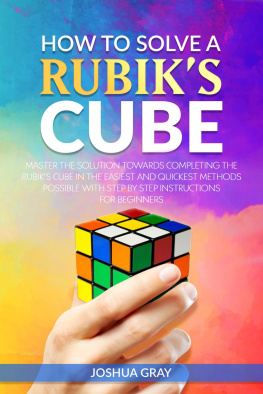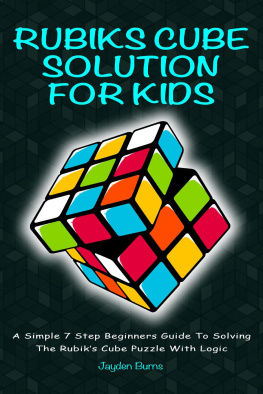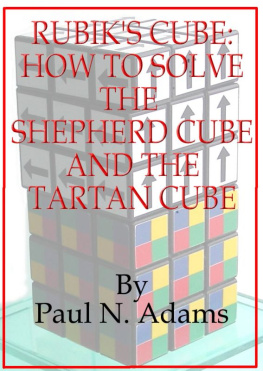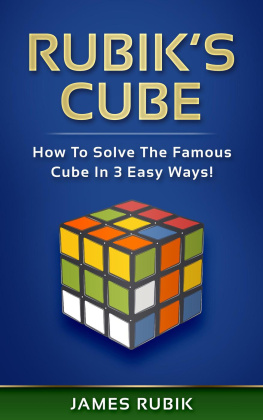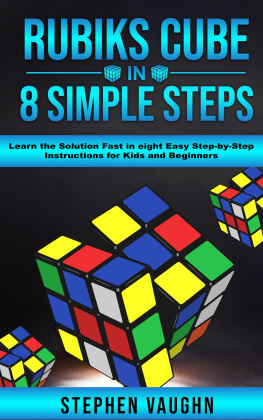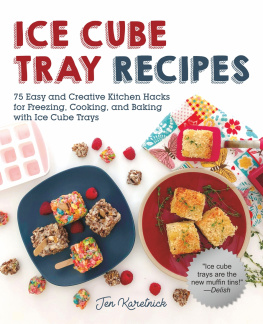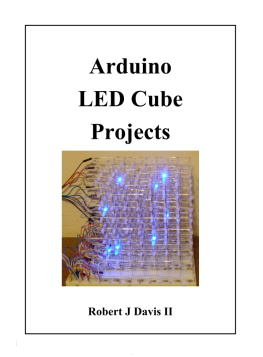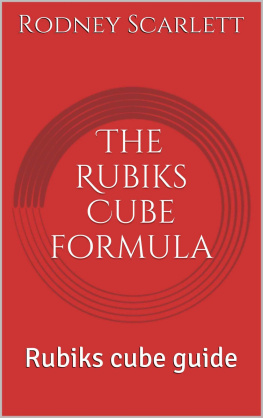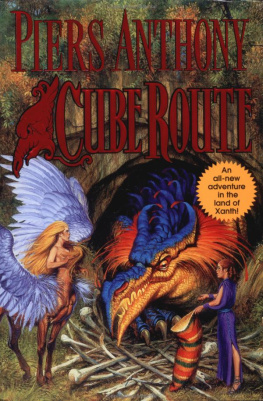Joshua Gray - How To Solve A Rubiks Cube: Master the Solution Towards Completing the Rubiks Cube in the Easiest
Here you can read online Joshua Gray - How To Solve A Rubiks Cube: Master the Solution Towards Completing the Rubiks Cube in the Easiest full text of the book (entire story) in english for free. Download pdf and epub, get meaning, cover and reviews about this ebook. year: 2018, publisher: Joshua Gray, genre: Children. Description of the work, (preface) as well as reviews are available. Best literature library LitArk.com created for fans of good reading and offers a wide selection of genres:
Romance novel
Science fiction
Adventure
Detective
Science
History
Home and family
Prose
Art
Politics
Computer
Non-fiction
Religion
Business
Children
Humor
Choose a favorite category and find really read worthwhile books. Enjoy immersion in the world of imagination, feel the emotions of the characters or learn something new for yourself, make an fascinating discovery.
- Book:How To Solve A Rubiks Cube: Master the Solution Towards Completing the Rubiks Cube in the Easiest
- Author:
- Publisher:Joshua Gray
- Genre:
- Year:2018
- Rating:5 / 5
- Favourites:Add to favourites
- Your mark:
- 100
- 1
- 2
- 3
- 4
- 5
How To Solve A Rubiks Cube: Master the Solution Towards Completing the Rubiks Cube in the Easiest: summary, description and annotation
We offer to read an annotation, description, summary or preface (depends on what the author of the book "How To Solve A Rubiks Cube: Master the Solution Towards Completing the Rubiks Cube in the Easiest" wrote himself). If you haven't found the necessary information about the book — write in the comments, we will try to find it.
Joshua Gray: author's other books
Who wrote How To Solve A Rubiks Cube: Master the Solution Towards Completing the Rubiks Cube in the Easiest? Find out the surname, the name of the author of the book and a list of all author's works by series.
How To Solve A Rubiks Cube: Master the Solution Towards Completing the Rubiks Cube in the Easiest — read online for free the complete book (whole text) full work
Below is the text of the book, divided by pages. System saving the place of the last page read, allows you to conveniently read the book "How To Solve A Rubiks Cube: Master the Solution Towards Completing the Rubiks Cube in the Easiest" online for free, without having to search again every time where you left off. Put a bookmark, and you can go to the page where you finished reading at any time.
Font size:
Interval:
Bookmark:
While every precaution has been taken in the preparation of this book, the publisher assumes no responsibility for errors or omissions, or for damages resulting from the use of the information contained herein.
HOW TO SOLVE A RUBIK'S CUBE: MASTER THE SOLUTION TOWARDS COMPLETING THE RUBIKS CUBE IN THE EASIEST AND QUICKEST METHODS POSSIBLE WITH STEP BY STEP INSTRUCTIONS FOR BEGINNERS
First edition. July 15, 2018.
Copyright 2018 Joshua Gray.
ISBN: 978-1386980650
Written by Joshua Gray.
10 9 8 7 6 5 4 3 2 1
Master The Solution Towards Completing The Rubiks Cube In The Easiest And Quickest Methods Possible With Step By Step Instructions For Beginners
Joshua Gray
...........................................................
.................................................................
................
..................
.....................................
Introduction
Thank you for taking the time to download this book: How To Solve A Rubiks Cube
This book covers the topic of Rubiks Cubes and will teach you how to easily solve one.
At the completion of this book you will have a good understanding of the tips, tricks and algorithms needed and be able to master the completion of the Rubiks Cube.
Once again, thanks for downloading this book, I hope you find it to be helpful!
 |  |



T he Rubik's cube is one of the most popular toys in the world today. For more than three decades now, it has provided entertainment and joy to all ages and is considered to be one of those iconic toys that can span generations and continue to be relevant despite the popularity of video games and smartphone apps. Just like other popular toys like Lego, Play-Doh, and Barbie, the Rubik's cube seems timeless in its appeal.
It is interesting to know then, that the Rubik's cube was not even originally intended to be a toy. This three-dimensional combination puzzle was invented by a Hungarian architecture professor and sculptor named Erno Rubik, and his original goal for the cube was to help him in explaining three-dimensional geometrical concepts to his students. During the 1970s, Rubik was teaching at the Department of Interior Design at the acclaimed Academy of Applied Arts and Crafts, located in Budapest, Hungary. The university is known for producing architects, visual communication designers, artists, craftsmen, and other artistic designers.
It is said that Rubik wanted to use the cube as a visual aid or teaching example in lecturing about 3D objects to his students, but Rubik's intention was primarily to come up with a solution for a structural problem of being able to move the cube's parts without the entire cube falling apart. As he designed the cube, he then scrambled it and realized that he had created a 3D puzzle as he tried to restore it to its original design. Rubik once wrote that he realized it was a code he had invented but could not read or solve himself. It took him over a month to finally solve the puzzle, with the use of a strategy which arranged each side's corners first.
He then obtained a Hungarian patent for his creation, calling it the Magic Cube, and was able to obtain patent HU170062 in 1975. Because Rubik was from Hungary which, at that time was behind the Iron Curtain, a few years of marketing the Magic Cube as a toy took place before he was able to get his invention recognized. By 1977, a few initial batches of the Magic Cube were produced and released in various toy shops around Budapest. The first batches featured interlocking plastic pieces (much like today's design) so the 3D puzzle could not be pulled apart or dismantled easily.
Two years later, a businessman named Tibor Laczi saw the Magic Cube and sought the permission of Rubik to take his creation to the 1979 Nuremberg Toy Fair in Germany. The Nuremberg Toy Fair was known for being the launching ground for many toys that eventually became popular throughout Europe and the rest of the world. At the Fair, Tom Kremer, the founder of Seven Towns company, saw the Magic Cube and expressed an interest in marketing the toy globally. By September of 1979, a deal had been struck with Ideal Toys for the worldwide release of the Magic Cube. Ideal Toys came up with the idea of trademarking a more recognizable brand name for the Magic Cube, and it was renamed Rubik's Cube in 1980.
By January and February of 1980, the Rubik's Cube was making the rounds of international toy fairs, debuting in London, New York, Nuremberg, and Paris toy fairs. It began attracting attention and the first global releases started in May of 1980. First sales were not as brisk as expected but picked up as Ideal Toys launched an advertising campaign for the Rubik's Cube in television and newspaper outlets. The campaign kicked off around the Fourth of July weekend in the United States and consisted of two straight weeks of TV ads featuring a 30-second commercial composed of three vignettes. This was followed by a whole month of three 10-second TV commercials utilizing one of the vignettes from the full version. Small-space newspaper advertisements were published in conjunction.
The advertising resumed after the summer, picking up in December and expanding to 100 major and mid-size markets by December. The tagline used for the campaign was, "Rubik's Cube, over 3 billion combinations, but just one solution". It highlighted the Rubik's Cube as a challenging and demanding toy, with emphasis on it being a high-level mathematical plaything that can stimulate the mind. Soon, the Rubik's Cube was winning awards, including a German Game of the Year awarded in 1980, and accolades such as Best Toy in the United States, United Kingdom and France. The awards catapulted the Rubik's Cube to worldwide phenomenon status. At the height of the craze from 1980 to 1983, about 200 million Rubik's Cubes were sold all over the world.

Image Credit: Shutterstock.com
I n March of 1981, the very first speed cubing championship featuring the Rubik's Cube was held in Munich, Germany, with no less than the Guinness Book of World Records organizing the said event. Also, in the same month, the Rubik's Cube was featured on the front cover of Scientific American . Three months later, a feature story that appeared in the Washington Post about the Rubik's Cube craze described it as 1981's equivalent to previous toy crazes such as the Bongo Board and Hula Hoop, describing the toy as "...a puzzle that's moving like fast food right now."
In the September 1981 issue of the New Scientist , Ros Herman wrote in his report Cubic Mastery that the Rubik's cube had gotten the attention of kids between the ages of 7 to 70 years old all through that summer, even dubbing the craze as cubitis. The phenomenon was so widespread that Herman's friend David Singmaster, a mathematics lecturer at London's Polytechnic of the South Bank, was giving almost a hundred percent of his time to the analysis, reporting, and marketing of the Rubik's cube, with focus on its educational value and its role in helping people understand some basic mathematical concepts.
Font size:
Interval:
Bookmark:
Similar books «How To Solve A Rubiks Cube: Master the Solution Towards Completing the Rubiks Cube in the Easiest»
Look at similar books to How To Solve A Rubiks Cube: Master the Solution Towards Completing the Rubiks Cube in the Easiest. We have selected literature similar in name and meaning in the hope of providing readers with more options to find new, interesting, not yet read works.
Discussion, reviews of the book How To Solve A Rubiks Cube: Master the Solution Towards Completing the Rubiks Cube in the Easiest and just readers' own opinions. Leave your comments, write what you think about the work, its meaning or the main characters. Specify what exactly you liked and what you didn't like, and why you think so.

